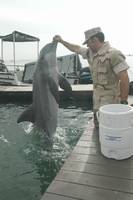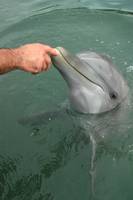|
Loma is a 23-year-old dolphin deployed to Bahrain
to protect ships and piers against terrorist attacks.
The Atlantic bottlenose dolphins train with a detachment of 13 sailors with Explosive Ordnance Disposal Mobile Unit 3 from San Diego.
“One of our guys gets in the water and simulates like he’s coming in to attack,” said Petty Officer 2nd Class Kevin Fogleman.
“Every night we do it just to calibrate and make sure the animal’s doing what he or she is supposed to be doing.”
For force protection reasons, the military will not say how effective the dolphins have been or whether they’ve come across any real enemy swimmers or divers, said Lt. Garrett Kasper, 5th Fleet spokesman.
“Regionally, if there were to be a swimmer attack like there was a small-boat attack on the [guided-missile destroyer USS] Cole, this is the area it would be in,” said Kasper, referring to the October 2000 terrorist bombing in a port in Yemen.
The program at the Mina Salman port, the Mark 6 Marine Mammal System, is one of five systems in the Navy Marine Mammal Program. Each has a different purpose, such as mine detection.
While military officials won’t say how many dolphins are deployed to Bahrain for the swimmer detection system, the overall program has 75 dolphins, 25 sea lions and a couple of beluga whales around the world, according to Tom LaPuzza, public affairs officer for Space and Naval Warfare Systems Center San Diego. As manager of the program for the chief of naval operations, the centre develops all of the systems and trains sailors to work with the animals.
Fogleman has worked with dolphins for 6½ years.
“It’s definitely draining. It takes a lot of time, working during your off hours,” said Fogleman, a senior trainer who supervises handlers in Bahrain.
“It’s not just a job where you come in, do your job and go home.”
Sailors in the job come from a range of job specialties, from damage controlmen such as Fogleman, to hull technicians.
They rotate in on six-month deployments to Bahrain to work with the dolphins, which range in size from 6 to 7 feet long and 300 to 500 pounds.
Each dolphin lives in a 30-by-30-foot open mesh pen, 15 feet deep.
“A lot of people say, ‘Oh, it’s terrible having them confined,’ ” said Lt. John Schiller, who is in charge of the detachment. “ But here they don’t have to worry about any kind of natural predators. We give them restaurant-quality food, better than most people would get.”
For the daily or nightly patrols, the dolphins swim untethered in open waters.
The dolphin either patrols around the port or is taken on a 22-foot-long boat that cruises to various places in the gulf. The animal is released and goes on searches, “wherever she thinks she needs to investigate,” said Fogleman, 26, from Oakland, California.
The dolphin emits a series of high-frequency clicks, sending out a sonar signal that bounces off objects in the environment. It reads the signal with its lower jaw.
Using its biological sonar, which is better than any manmade sonar, a dolphin can tell the difference between a ping-pong ball and golf ball in the water just based on density.
“It basically provides them with a three-dimensional picture of the water they search,” said Schiller 40, from St. Paul, Minn. “They can tell that’s a pier, that’s a rock, that’s a boat.”
A dolphin indicates it has detected a possible enemy in the water by bumping a black Styrofoam ball on the side of the boat. The team then notifies the harbour patrol unit of the threat.
If the dolphin fails to pick up on a threat, “we don’t do any negative punishment, we just bring them right back and keep working them,” Fogleman explained, while feeding fish to a dolphin named Loma. In the adjacent pen, Fathom splashed at visitors.
Fogleman smiled, saying dolphins sometimes splash people out of jealousy when they aren’t getting as much attention as Loma, for example, his favourite.
“She’s got the most personality,” he said. “You can tell she’s thinking about what you’re going to do, what she wants to do.”
And sometimes she tries to manipulate her handlers, he said, “milk the situation, you know, try and get special treatment. … She’ll sit here and try to milk you for food all day long by doing her own little tricks. … ”
Loma, 23, was captured in the Gulf of Mexico before the Navy stopped capturing mammals in 1989.
LaPuzza said that since the program was founded in 1960, there have been more than a half-million releases — during which time the mammals train or patrol untethered in open waters — and only seven mammals have not returned.
Dolphins were first operationally deployed during the Vietnam War from 1971 to 1972 and in Bahrain from 1986 to 1987 during the Iran-Iraq war.
Before the new team of dolphins arrived last spring in Bahrain, sea lions were deployed here to test the Shallow Water Intruder Detection System from January through April.
In that system, a sea lion would chase an enemy swimmer or diver with a clamp in its mouth, and place it on the intruder’s leg. Using a line attached to the clamp, sailors could reel in the attacker. LaPuzza said that while the training went well, the system isn’t being used at this time.
U.S. military officials said it isn’t known how long the dolphins will be deployed to Bahrain, but say they will remain as long as it is believed they are needed.
“Right now, the threat is here,” said Schiller. “If the threat were to change and go somewhere else, we can be up and moving to that place within 72 hours’ notice.”
Top
|

